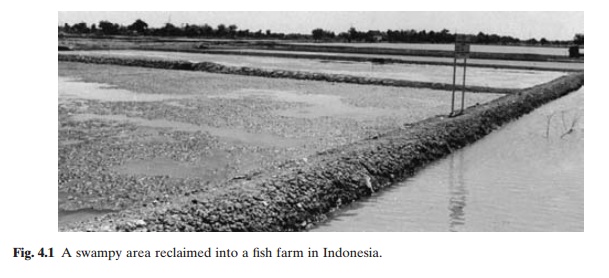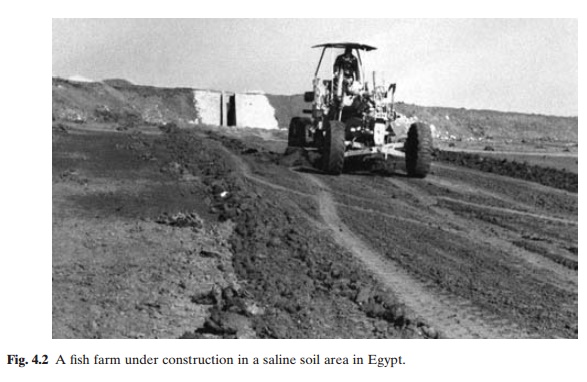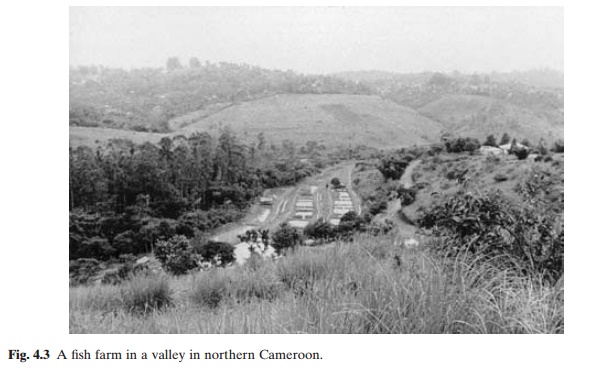Chapter: Aquaculture Principles and Practices: Selection of Sites for Aquaculture
General considerations - Selection of Sites for Aquaculture
General considerations
Although many of the factors to be investigated in the selection of
suitable sites will depend on the culture system to be adopted, there are some
which affect all systems, such as agroclimatic conditions, access to markets,
suitable communications, protection from natural disasters, availability of
skilled and unskilled labour, public utilities security, etc.. It may be
possible to find solutions when these factors are unfavourable and present
problems, but it would involve increased investment and operating costs and
would affect profitability. In the case of small-scale aquaculture, it is
necessary to determine that the selected site has easy access to materials that
cannot be produced on the farm and that the necessary extension services are
available.
All available meteorological and hydrological information about the area
(generally available from meteorological and irrigation authorities) such as
range and mean monthly air temperature, rainfall, evaporation, sunshine, speed
and direction of winds, floods, water table, etc., have to be examined to
assess their suitability.
In land-based aquaculture, the most commonly used installations are pond
farms and hatcheries. Since most such farms have earthen ponds, soil characteristics,
the quality and quantity of available water and the ease of filling and
drainage, especially by gravity, are basic considerations. For fresh-water pond
farms, the land available consists mainly of swamps, unproductive agricultural
land, valleys, stream and river beds exposed due to changes of water flow, etc.
(figs 4.1–4.3). Land elevation and flood levels have to be ascertained. The
maximum flood level in the last 10 years or the highest astronomical tide (in
the case of brackish-water sites) should not be higher than the normal height
of the dikes that will be constructed for the farm. It will be advantageous to
select land with slopes not steeper than 2 per cent. The area should be
sufficiently extensive to allow future expansion and preferably be of regular
shape to facilitate farm design and construction.
The nature of the vegetation indicates the soil type and elevation of
the water table. Obviously dense vegetation, particularly tall trees, makes
clearing more difficult and expensive.



Land under grass or low shrubs is much better suited in this respect.
However, in areas exposed to strong winds and cyclonic or similar weather
conditions, sufficiently tall vegetative cover around the farm can serve as an
effective wind breaker. High ground-water level may create problems in farm
operation, as drainage will become difficult and expensive. The use of
mechanical equipment for pond construction will also become inconvenient.
Among the other important general factors to be considered are the
existing and future sources of pollution and the nature of pollutants. In this
connection, information on development plans for the neighbourhood areas will
be necessary. It will be useful to ascertain the past use of the site, if any.
Croplands that have been treated for long periods with pesticides may have
residues that are harmful to fish and shellfish. If the site is located
adjacent to crop-lands that are sprayed from air or land, there is the risk of
contamination occurring directly or through run-off water. Similarly, the
possible effects of discharges from the pond farms into the waterways and
irrigation systems in the neighbouring area should be considered. This can
greatly influence the attitudes of the neighbourhood communities to the
proposed farming and hence their future cooperation.
When a hatchery is planned in connection with a pond-rearing facility,
the selection of its site depends on the location of the nursery and rearing
ponds. The more important consideration is the unrestricted availability of
good-quality water, such as from springs, tube wells, reservoirs, etc. If
earthen nursery ponds are to be constructed alongside the hatcheries, it is
necessary to ensure the quality of the soil for pond construction and pond management.
In many modern hatcheries, fry rearing is mostly done in tanks and troughs,
with as much control over ambient conditions as possible. So the main
consideration is the availability of essential utilities such as electricity.
The situation is very similar for the selection of sites for raceway farms.
When the raceways are made of cement concrete the main consideration is the
availability of adequate quantities of good-quality water and essential
utilities.
The choice of sites for integrated aquaculture – such as fish culture
combined with crop and livestock farming – is governed by factors other than
their mere suitability for aquaculture. Land available for integrated
aquaculture is generally agricultural land, even if it is some-what less
productive. A satisfactory irrigation system is likely to have been developed
for agriculture, in which case water and soil management can be expected to be
easier. Since integrated farming is based on the recycling and utilization of
farm wastes, problems of pollution can be expected to be minimal.
Related Topics